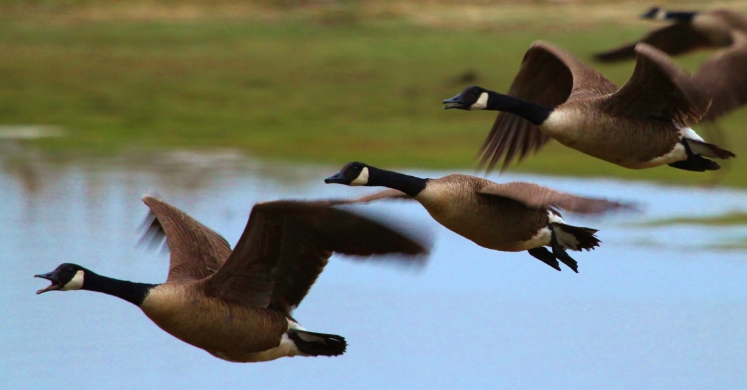Blog

#bioPGH Blog: Canada Geese in Pittsburgh
 A resource of Biophilia: Pittsburgh, #bioPGH is a weekly blog and social media series that aims to encourage both children and adults to reconnect with nature and enjoy what each of our distinctive seasons has to offer.
A resource of Biophilia: Pittsburgh, #bioPGH is a weekly blog and social media series that aims to encourage both children and adults to reconnect with nature and enjoy what each of our distinctive seasons has to offer.
This past weekend on a walk along the Monongahela River, I spotted six families of Canada geese together along the shore—each family with a little brood of goslings. The young of each family differed in age by a few weeks, but all were still yellow-gray and quite fuzzy. My fellow walkers edged cautiously past the relatively small space along the shore with the feathered families, and a few of the adult geese stared down each new person, bike, or dog as a potential threat. Most of us are familiar with this defensive behavior of Canada geese, which can even become problematic when large groups of geese are in city parks and or decide to nest right in the middle of crowded places. There is quite a bit more to the feisty Canada geese than meets the eye, though—let’s explore!
Across North America, there are multiple recognized subspecies of Canada goose. Broadly speaking, the variation across subspecies follow the trend that as you travel west, the birds are darker in color. Also, in a bit of a reversal to a common pattern of wildlife size, as you move southward, the geese are larger. (Bergmann’s Rule is a biology principle that within most animal species, populations that live closer to poles tend to be larger in size.) All of the subspecies are migratory, but their migration patterns vary. Some populations will travel thousands of miles each season when flying south, but some only go a short distance south (Indiana and Ohio’s geese, for example, often don’t even leave the state.) Here in Pennsylvania, our own geese fly south for the winter, but the geese from Canada can either pass through or even overwinter here. Generally, our state will only be a migratory rest stop, but a handful of warmer winters have invited northern geese to stay for a while. Regardless of subspecies, though, Canada geese are generally herbivorous, and graze for plant material while occasionally ingesting an insect or two. And across subspecies, pairs tend to be monogamous and mate for life.
Despite their current abundance, it is strange to think that in the first half of the twentieth century, Canada geese suffered severe population declines across the US and were completely extirpated (locally extinct) in some areas. A combination of overhunting and drained wetland habitats across the US both contributed to their decline, but federal protections under Migratory Bird Treaty Act helped regulate hunting. Today, though, Canada geese are abundant to the point of nuisance in town parks and ponds. Part of the reason for their success is that geese have adapted incredibly well even to heavily urbanized areas, and they have few remaining predators. In addition, descendants of the geese that were relocated as a part of conservation efforts in the mid-twentieth century ultimately expanded outside of the geese’ original range. All of this sets the stage for quite a gaggle of geese!
Whether they’re a nuisance or not, Canada geese are prominent part of Pittsburgh’s urban wildlife. And when you think about it, they have proven themselves to be hardy and resilient, just like Pittsburghers!
Connecting to the Outdoors Tip: You don’t have to travel far to find a pond or stretch of river with geese. If you do spot geese or other water fowl, it’s important to resist the urge to feed them, especially bread or other human food. Feeding bread to birds is detrimental to their health because our bread provides them with little nutritional value but fills their stomachs so they don’t forage for their natural diet. Feeding the birds at ponds also creates the association of people and food, which can make geese more aggressive and demanding.
Continue the Conversation: Share your nature discoveries with our community by posting to Twitter and Instagram with hashtag #bioPGH, and R.S.V.P. to attend our next Biophilia: Pittsburgh meeting.
Resources
Cornell Lab of Ornithology – Canada Goose
National Geographic – Canada Goose
Indiana Department of Natural Resources—The Truth about the Canada Goose
PA Game Commission – Canada Goose
Photo credits: Wikimedia users Bear Golden Retriever CC-BY-2.0 and Neonorange CC-BY-SA-3.0

